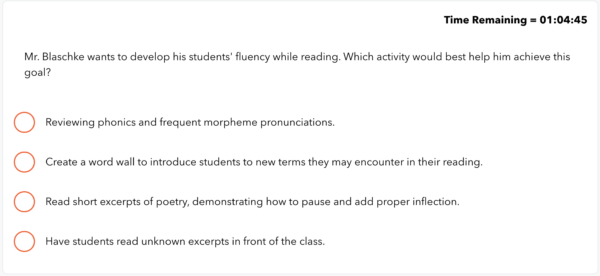What Is a Passing Score on the FTCE Elementary Education K-6 (060) Exam?
FTCE exams are graded by scaled scores rather than percentage scores. A passing score for the FTCE K-6 exam is a scaled score of at least 200 for each of the four subtests: Language Arts and Reading, Social Science, Science, and Mathematics.
How Do You Pass the FTCE Elementary Education K-6 (060)?
To reach a scaled score of 200, you’ll need to answer approximately 70-75% of the questions correctly. Due to the scaled scoring system, this percentage may be slightly lower or higher for different versions of the exam, but it gives you a good indication of what you need to work towards. Remember, you have to pass all four subtests to pass the overall exam.
How Hard Is the FTCE K-6 Exam?
The FTCE K-6, like most FTCE exams, can be challenging. The FTCE pass rates in 2020 ranged from 51-64% depending on the subtest. While this may sound scary, the right study tools and strategies will greatly increase your chances of passing this exam.
In addition to being challenging, the K-6 exam is long. The first time you take the K-6, you’ll need to take all four subtests. This can take almost five hours. However, using our FTCE K-6 Study Guide and practice tests can help prepare you for this lengthy exam.
What Are the Best Resources To Use To Pass the FTCE Elementary Education K-6 (060)?
To prepare for any exam, you need to use reliable, accurate, and up-to-date resources. The testing company, NES, publishes a few resources to help prepare you for your exam, including practice questions and a list of exam competencies. However, most test takers find that they need something that goes a bit further than this.
In order to feel fully prepared on your exam day, you’ll most likely need to use a study guide. 240 Tutoring has a comprehensive study guide for the FTCE Elementary Education K-6 exam. This guide covers all four subtests with in-depth study material and includes over 1,000 practice questions.
Another free resources is our FTCE Elementary Education K-6 practice test and test overview. This resource is completely free and provides a brief overview of many topics you might see on the exam. If you’re feeling pretty confident about your exam and just need to brush up on a few concepts, this may be the right option for you.
Not sure which resource to use? Try our free practice tests to see where you stand. You’ll even be timed, as shown in the picture below, so you can get a full picture of how prepared you are.

How Should You Study For the FTCE Elementary Education K-6 (060)?
Start by familiarizing yourself with the structure of the FTCE K-6 exam and reading a basic overview of each subtest. Next, try 240 Tutoring’s time practice test for each subtest: Language Arts and Reading, Social Science, Science, and Mathematics. This is a good way to identify your strengths and weaknesses and determine just how much studying you will need to do. Use the results of your diagnostic assessment to create a study plan and schedule that allows you to cover each concept that you need to work on. If possible, leave extra time to review your areas of strength as well.
After creating a study plan and schedule, use our FTCE Elementary Education K-6 guide to carefully study each topic that might come up on the exam. Take notes of important concepts, and be sure to try the practice questions throughout the study guide as a way to gauge your understanding.
A week or two before your exam, try our timed practice test once more to see where you stand. Don’t wait until the last minute to do this — if you aren’t happy with your score, you’ll want to make sure you still have time for more studying!
When Should You Start Studying for the FTCE Elementary Education K-6 (060)?
Study time will vary for each individual test taker, but you should plan on studying for at least several weeks leading up to your exam. Start by assessing your current knowledge in all four content areas, then use this information to create a list of topics you need to work on. Next, work backward from your exam day to create a schedule that gives you enough time to study each topic. Plan to study at least a few times each week to ensure that the content stays fresh in your mind. You may also find it helpful to study at the same time every day so that it becomes part of your routine.
Already close to your exam? We’ve all been there. While cramming isn’t the ideal option, check out Dr. Kristy Mulkey’s tips for “Effective Cramming” to make the best of a tough situation.
What Happens If You Fail the FTCE Elementary Education K-6 Exam?
It can be discouraging to think about the possibility of failing your exam. However, the good news is that if you do fail one or more subtests on the FTCE K-6 exam, you only need to retake the subtest(s) that you did not pass.
Keep in mind, however, that you will have to register and pay to take the subtest(s) again. You also have to wait at least 31 days from your last testing attempt before retaking any of the subtests. So while failing your exam isn’t the end of the world, you do want to make sure you are as prepared as possible the first time around.
How Do You Interpret Your FTCE Elementary Education K-6 Score Report?
Within four weeks of your testing date, you’ll have access to your official score report. Your FTCE Elementary Education K-6 score report will indicate “pass” or “not pass” for each individual subtest. If your report shows “pass” for each subtest, congratulations – you passed the FTCE Elementary Education K-6 exam! If you didn’t pass one or more subtests, you’ll see “not pass,” along with a numeric score indicating how you performed on that subtest. (You won’t get a numeric score if you pass the exam.) These numeric scores can help with future studying, as you’ll want to focus most on the subtest you scored the lowest on.
Ready to start studying? Go ahead and take our practice tests and check out our FTCE Elementary Education K-6 study guide. Still have a few more questions? Check out our other FTCE articles, including the FTCE Questions Quick Guide and Which FTCE Exams You Need To Take.




